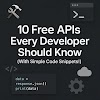Becoming a full stack developer means you can build both the frontend (what users see) and the backend (what powers everything behind the scenes). Whether you're new to coding or switching roles, this roadmap is your friendly guide to mastering full stack development in a practical, project-oriented way.
🚀 Why Learn Full Stack Development?
- 🌐 Work on complete apps from start to finish
- 💼 Higher demand = more job opportunities
- 🧰 Learn how everything fits together (frontend, backend, database, deployment)
- 💡 Ideal for freelancers, startups, or career changers
Let’s break it down step-by-step. Each section includes a mini-code snippet or tool suggestion to help you start learning by building, not just watching!
🔧 1. Start with the Basics: HTML, CSS & JavaScript (Frontend Foundation)
🧱 HTML Structure
<!DOCTYPE html>
<html>
<head>
<title>My First Web Page</title>
</head>
<body>
<h1>Hello, world!</h1>
</body>
</html>
What this does:
This is the skeleton of every web page. HTML defines the structure: headings, paragraphs, buttons, and forms.
👉 Learn next: Lists, tables, links, forms.
🎨 CSS Styling Basics
body {
background-color: #f4f4f4;
font-family: sans-serif;
color: #333;
}
What this does:
Styles your webpage — layout, colors, fonts, responsiveness.
👉 Learn next: Flexbox, Grid, media queries (for mobile-friendly design).
⚙️ JavaScript Fundamentals
document.querySelector("h1").textContent = "Hello from JS!";
What this does:
JavaScript lets you interact with the DOM, change page content, and build dynamic features.
👉 Learn next: Variables, functions, arrays, loops, DOM manipulation, events.
✅ Pro Tip: Build a To-Do App using HTML + CSS + JavaScript to practice these together.
🗂️ 2. Learn a Frontend Framework (Like React)
🧩 JSX in React
function App() {
return <h1>Hello React!</h1>;
}
Why React?
It's beginner-friendly, widely used, and fast to learn. Use it to build interactive UIs and components.
👉 Learn next: Props, state, components, event handling, forms.
🖥️ 3. Understand the Backend (Node.js or PHP)
🛠️ Simple Express.js Server
const express = require("express");
const app = express();
app.get("/", (req, res) => {
res.send("Backend is working!");
});
app.listen(3000, () => console.log("Server running on port 3000"));
What this does:
Creates a local server using Node.js and Express. Handles requests and responses — the foundation of APIs.
👉 Learn next: Routing, REST APIs, middleware, authentication.
💾 4. Learn Databases (SQL & NoSQL)
🗃️ MongoDB Example
const mongoose = require("mongoose");
mongoose.connect("mongodb://localhost:27017/mydb");
const User = mongoose.model("User", { name: String });
const user = new User({ name: "Alice" });
user.save();
Why MongoDB?
Easy to use with JavaScript/Node.js, flexible schemas, popular in startups.
👉 Learn next: Queries, schema design, relationships.
🔐 5. Add Authentication (Login/Signup Systems)
🪪 JSON Web Token (JWT) Usage
const jwt = require("jsonwebtoken");
const token = jwt.sign({ userId: 123 }, "secretkey");
Why JWT?
Used to securely transfer user identity between client and server.
👉 Learn next: Passport.js, session handling, OAuth (for Google/GitHub login).
🚀 6. Learn Deployment (Host Your App Live)
☁️ Deploying to Netlify (Frontend)
- Connect GitHub repo
- Drag-and-drop build folder
- Done ✅
🐳 Docker (Backend or Full Stack)
FROM node:18
WORKDIR /app
COPY . .
RUN npm install
CMD ["node", "index.js"]
Why this matters:
Deploy your full stack apps like a pro. Learn GitHub, CI/CD, and deployment platforms (like Netlify, Vercel, Render, or Heroku).
📚 Final Roadmap Overview (Bookmark This!)
- ✅ HTML, CSS, JavaScript
- ✅ Build projects (To-Do app, Portfolio site)
- ✅ Learn Git & GitHub
- ✅ Master React or frontend framework
- ✅ Learn backend (Node.js + Express OR PHP)
- ✅ Add MongoDB or PostgreSQL
- ✅ Implement user auth
- ✅ Deploy it all live
- ✅ Practice with real-world clones (like Instagram, Trello, or Blog app)
🧠 Best Practices for Full Stack Developers
- 📁 Keep your code modular (split frontend/backend logic)
- 💬 Comment clearly and concisely
- 🔄 Practice Git version control daily
- 🌐 Use
.envfiles to hide secrets - 🔍 Use DevTools and Postman for debugging
- 📦 Learn package managers (npm, pip, composer)
💡 SEO & Performance Tip
A good full stack dev understands frontend performance impacts SEO. Faster page loads, clean HTML, and semantic tags improve ranking. Backend skills help optimize APIs and reduce server load — boosting user experience and conversions.
🎯 Conclusion
You don’t need to learn it all at once — take one step at a time and build as you go. Whether you're dreaming of freelancing, building your own product, or getting hired as a junior dev, this roadmap gives you a clear, practical path to success.
✨ If you're stuck, start small: build a portfolio, deploy your first project, and grow from there. You got this!
👉 Want to practice these skills? Check out our full app clone projects












0 Comments